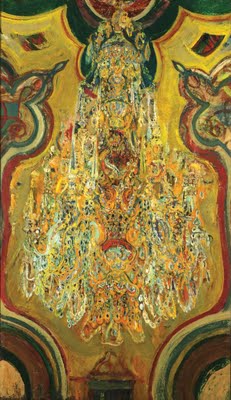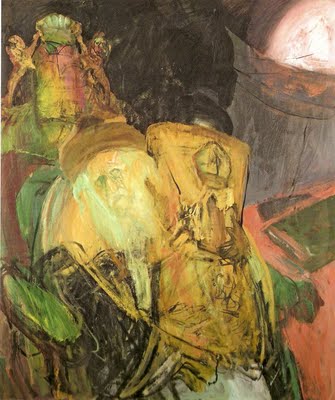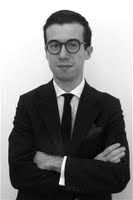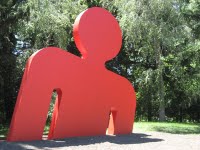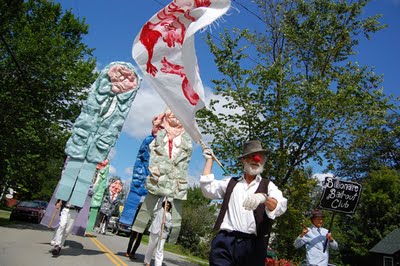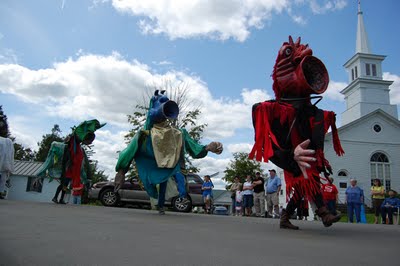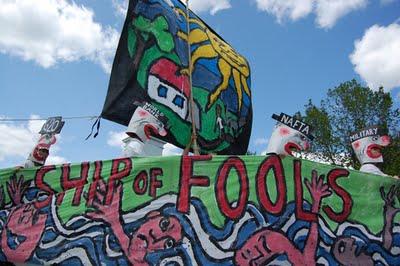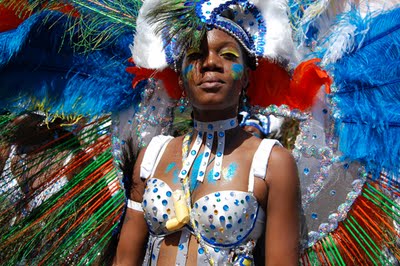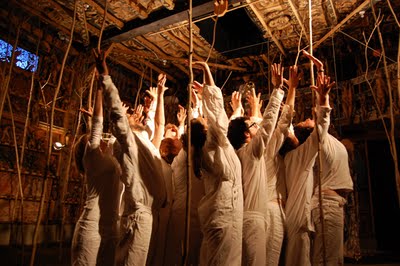 Bread and Puppet Theater
Bread and Puppet Theater’s Lubberland National Dance Company’s “13 Dirt Floor Cathedral Dances” is a mixed bag about New York rush hour, Killed Palestinian children, American bombing of Pakistani villages, deforestation and development sprawl, religion, and who knows what else. Early sections deploy haunting sets, costumes and careful movement to build a strange, mournful mood. But as the show moves away from masks and props in the second half, and turns to just dance, it loses its precision, and power.
The performance opens outdoors, with white-clad performers forming a large circle around grass between the museum barn and the Dirt Floor Cathedral (formerly known as the New Barn). They lean one way, then the other, then trot around the circle. They group near the cathedral and make two approaches to its door, but the door only opens after Bread and Puppet founder Peter Schumann bangs a gong hanging beside the entrance. The crowd is welcomed in. A couple dozen bare tree branches are planted upright in the barn’s dirt floor and reach nearly to the ceiling. A shallow papier-mâché relief screen of writhing people stands at the back of the stage.
“The Lubberland National Dance Company presents ‘13 Dirt Floor Cathedral Dances,’” a woman announces at the barn door. “The first dance is the ‘New York City Rush Hour Crowd Forest Admiration Dance.’” She leads the cast into the theater, all shuffling and making chugging motions, as they snake between the trees. At one point they raise their hands to the ceiling, with mouths open. Then they shuffle out a curtain at the back of the stage.
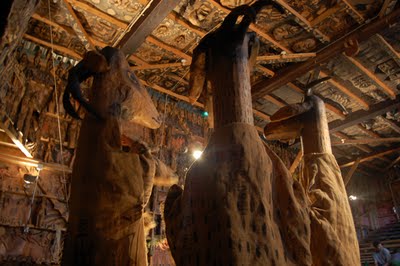
The announcer woman returns to the darkened theater, stands before the screen, in the light of a spotlight mounted in the dirt floor, and says, “The second ‘Dirt Floor Cathedral Dance’ is ‘Sleep.’” She introduces a hobo-like character in a gray mask, saying, “And this is the sleeper. And these are the names of the children who were killed in Gaza in last January’s attacks.” Together they unfurl a white banner, that spans the width of the room, and is covered with dozens of names scrawled in black. “Music please,” she says. Standing along the stairs on either side of the bleachers, performers, wearing goat masks and burlap sack costumes, tug cords that cause sticks to slap against the ceiling. The Announcer and the Sleeper fold the banner up into a bundle, which they tie to the end of the Sleeper’s stick. “And here is a pillow for the sleeper,” the Announcer says.
The Sleeper circles the floor spotlight and raises a lit lantern toward the balcony above the back of the stage. A chorus of performers enters the balcony from each side, hooting on empty bottles, and lines up along the railing, filling the whole balcony.
The Sleeper nears the black-curtained exit at the left rear of the stage as a performer in a horse mask enters, bobbing, and stops at the floor spotlight. The balcony Chorus clinks bottles as the Goats come down onto the stage and circle the Horse. The Sleeper returns to the left rear exit as a Soldier, in helmet and cardboard bandolier, carrying a metal pail and crude horn, marches in with a stiff robotic gait. A masked performer, the “Professor,” trails him, darts around. The Soldier marches to the front left, while the Professor goes to the Horse, bends it over and turns a crank on its back. The Goats return up the stairs as the Chorus clinks bottles. Horse and Professor exit, just as three performers in white moon-faced women masks and black gowns enter. One lays before the floor spotlight, as the others bob, sometimes covering their eyes. A performer in a Bird mask comes in, and seems to feed from the Sleeper’s hand. The Goats slap the sticks on the ceiling again. The Bird exits as the Chorus hoots on their bottles. The white woman rises from the light. The three women wave goodbye to the Sleeper and slowly exit.
The Sleeper lays down next to the floor spotlight. The Goats return to the stage floor and circle the Sleeper, as the Chorus clinks bottles and the Soldier struts to the rear of the stage. The Soldier clangs his horn against his bucket, blows a farty blow on the horn, and exits. The Chorus exits the balcony.
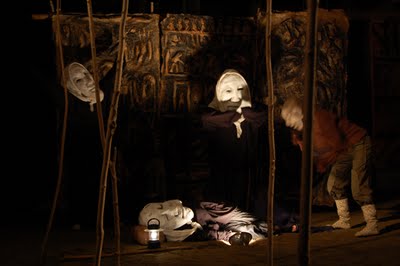
“The third ‘Dirt Floor Cathedral Dance’ is the ‘Dance of the Foolish Woman Who Tries to Bring Back the Victims of Drone Bombardments on Pakistani Villages,’” the Announcer says, standing between the Sleeper on the floor and the screen. A man with a wheelbarrow enters leading a line of four pipers – the fourth masked in a grassy costume. Stopping at the front right of the stage, the wheelbarrow guy digs a shovel into the wheelbarrow making an awful metal and gravel noise. A performer in a horned mask enters, shakes a rattle, clangs a little cymbal over the Sleeper. Two other masked characters enter and solemnly study the scene. The grassy piper hauls the screen into the air by ropes, revealing three large wooden wheels of a clockwork device on the back wall, which he sets spinning.
The Sleeper rises and goes to the rear right exit as a performer wearing a white mask with black hat (Schumann’s Butcher character, which often symbolizes bureaucrats who order mass violence), a dark suit, and on stilts walks in holding a crude cardboard airplane and making a buzzing noise. The Butcher walks across the back of the stage and exits out the rear left. Suddenly, shockingly something falls from the ceiling and thumps onto the dirt floor. It’s a simple gray stuffed fabric corpse. Another Butcher on stilts with a plane crosses the back of the stage, another corpse falls to the ground. And then a third Butcher and corpse. All this time, the clockwork spins and bangs and clangs.
The masked characters on the stage circle and study the corpses. The masked piper stills the clockwork and lowers the screen again as the other pipers play. A performer (Schumann) masked as a white woman with long blonde hair and in a white gown (this is a character that appeared in the mid 1970s in a “Gray Lady Cantata” and as an angel who resurrects animals killed by the Butchers in the original “White Horse Butcher” show). She dances over the corpses. Up on the balcony, drums race. She picks up one of the corpses, brings it to the front of the stage, blows on it, then drops it to the floor. She picks up a send corpse, and throws her arms into the air and writhes. She drops the second corpse and picks up the third corpse and holds it over herself in a sort of crucifixion pose, and dances convulsively. Then she drops the corpse to the floor. The wheelbarrow man and pipers gently, tenderly load the corpses into the wheelbarrow and all exit.
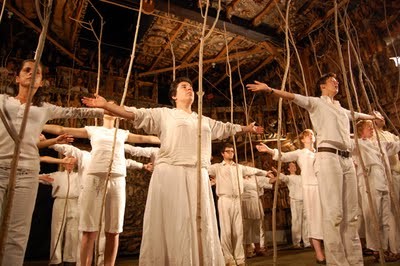
“The fourth ‘Dirt Floor Cathedral Dance’ is the ‘Deforestation Dance to Create Parking for Deforesters,’” the Announcer says after entering. The theater lights up, the floor spotlight is ripped out of the floor. Fiddlers on the balcony pick at their instruments as the Announcer leads the maskless, white-clad cast as they all shuffle into the room. Each performer stops at one of the trees. They each lean into the branch and throw their arms up toward the ceiling, then stretch their arms out horizontally, then hug the branches with their eyes closed. To slow, sour fiddling, they rock the trees back and forth before lowering their hands to their sides with a slap. They grip the trees stiffly and shake them maniacally to nervous fiddling. Finally they reach down and yank the branches from the dirt, walk to the left of the hall and silently lay them across the floor. The barn door rumbles open and, to squeaky haunted-house violin, the performers dash out dragging the branches behind them. Schumann enters, without a mask, through the same door, prances across the stage tossing little cardboard cars into the air, and exits out the back.
Dances six to 12 are performed to honking, dissonant brass from the balcony. Performers group up and perform a limited selection of actions in various combinations. Some bend over, hold their ankles, and stop around. Some line up and move their arms like train gears. Some line up and hold each other’s heads as they bob them back and forth. Some clap their hands out as they stride forward. Some lean back to back and slowly squat to the floor. Some lean one hand to the floor as they lift one leg into the air.
“And finally number 13,” one of the trumpeters on the balcony announces. The performers line up around the walls as Schumann stands with a violin behind a music stand at the center and says, “Number 13 is a sermon dance danced by the deeply superstitious practitioners of the papier-mâché religion.” He squeakily saws on his violin as the dancers improv around him – pointing to the ceiling, crouching down, hopping, leaning this way and that. “Papier-mâché religion is a religion without feet because it does not have to go anywhere. And unlike other religions is unnecessary. And this unnecessary is exactly what necessitates it. It emerges from the depths of nowhere … Papier-mâché religion simply says to them [traditional religions] please. However in the case of the divinely inspired or throat-cutting or F-16 bombardments you can’t say please. You appeal to the part of the brain … that deals with reason. … Only to yield to the obviously religiously-organized reality. The bloodthirsty Greek gods who seem Christian compared to the gods of Christianity … can easily serve as interpreters of planetary collapse. Papier-mâché religion says that religion is the nonsense that life needs to make sense. And since even papier-mâché wants to make sense it needs a religion. … And finally papier-mâché is an all purpose generic religion, which means going back to the origin. The origin of what? Sky and papier-mâché … Hallelujah! … Amen! … Tah-dah!” All the cast hops up and down. The end.
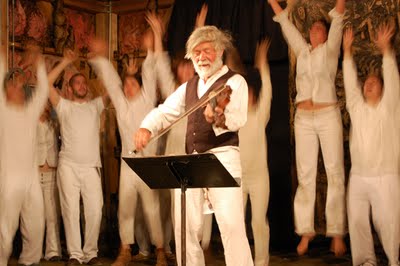
The various sections feel separate, like a buffet dinner, with the stated subjects all over the map. The second two dances, inside the barn, are striking with the trees, dark lighting, slow curious movements of the masked performers, the magnetic images and poetic spell of the interaction of the hobo, goats, soldier, corpses, men with airplanes. Tossing “corpses” from the ceiling to the floor – a motif Schumann used in recent years as symbols of the 9/11 attacks – continues to be heartwrenching. I wonder: is the sleeper a dreamer observing the happenings? Or perhaps a witness to horrors who does nothing?
But the carefully built mood comes apart in the second half, after the dance in which performers clutch, sway and rip up the trees. There the movements hold you with their specificity and purpose and strangeness. If it ended then, you might say you’re not quite sure what it all means, but it was excellent. The later dances, coming quickly one upon the other, feel like half-baked studio exercises. This problem continues in the improvised group dancing behind Schumann as he delivers his fiddle sermon at the end. The dull movements drain the power built in the early sections. And instead of helping the parts feel like they’re building to a greater whole, they come to seem all the more disparate and random. Schumann’s final sermon sounds somewhat generic – a pastiche of past sermons about the worth or worthlessness of art and religion in the face of societal violence. It seems to end because it’s hit some invisible time limit, not because this is where the ideas lead, not because this is where things have built to.
Bread and Puppet Theater’s Lubberland National Dance Company’s “13 Dirt Floor Cathedral Dances,” 753 Heights Road, Glover, Vermont, each Friday night at 8 p.m. from July 10 to Aug. 28, 2009.Photos by The New England Journal of Aesthetic Research. See more
here.





